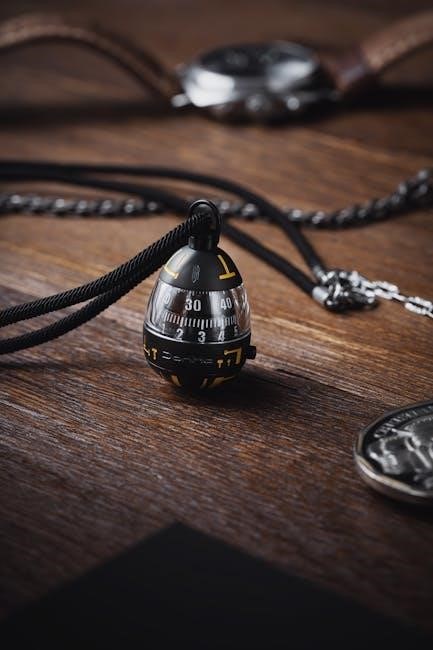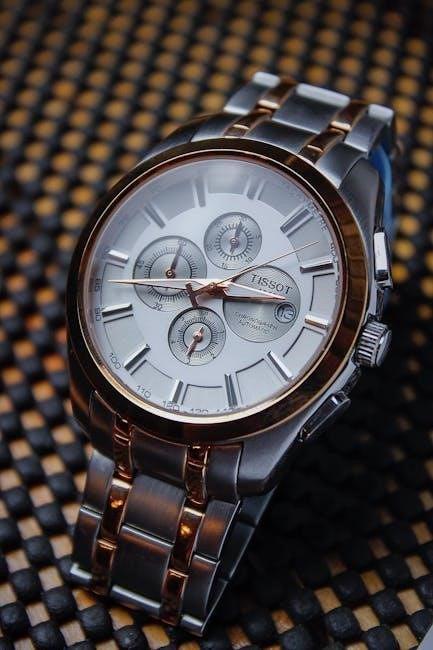
watch measurement guide
Welcome to the watch measurement guide, your ultimate resource for understanding the importance of accurate measurements in selecting the perfect timepiece. This guide will help you master the basics of measuring case diameter, lug width, and wrist size to ensure a comfortable and stylish fit.
1.1 Importance of Proper Watch Measurements
Proper watch measurements are essential for ensuring a comfortable and stylish fit. Incorrect measurements can lead to discomfort, poor aesthetics, or even damage to the strap. Measuring key dimensions like case diameter, lug width, and wrist size helps determine the ideal watch proportions for your wrist. Accurate measurements also guide strap width selection and ensure the watch sits correctly, avoiding issues like slipping or digging into the skin. This attention to detail enhances both functionality and personal style, making proper measurement a cornerstone of watch ownership.
1.2 Purpose of the Guide
This guide is designed to provide a comprehensive understanding of watch measurements, ensuring you select the perfect timepiece for comfort and style. It covers key dimensions like case diameter, lug width, and wrist size, offering practical steps to measure accurately. By following this guide, you’ll learn to use tools such as calipers and rulers effectively, avoid common mistakes, and understand how measurements impact fit. Whether you’re a seasoned collector or a first-time buyer, this guide empowers you to make informed decisions and enjoy a flawless watch-wearing experience.

Understanding Key Watch Measurements
Accurate watch measurements are crucial for a perfect fit. Key measurements include case diameter, lug width, and lug-to-lug length, ensuring comfort and style tailored to your wrist size.
2.1 Case Diameter Measurement
Measuring the case diameter is essential for determining the watch’s size. It is measured across the case from one edge to the other, excluding the crown. Use a caliper or ruler for accuracy. The diameter typically ranges from 36mm to 46mm for men and 28mm to 34mm for women. This measurement helps ensure the watch fits comfortably and suits your style. Accurate case diameter measurement is crucial for selecting the right size, ensuring both comfort and aesthetic appeal on your wrist.
2.2 Lug Width Measurement
Lug width is the internal distance between the two lugs on a watch case, where the strap or bracelet attaches. It is measured in millimeters using calipers or a ruler. Place the tool between the inner edges of the lugs and record the measurement. Lug widths typically range from 14mm to 22mm, with common sizes being 18mm, 20mm, and 22mm for men, and 14mm to 16mm for women. Accurate lug width measurement ensures the strap fits securely, preventing it from being too tight or loose.
2.3 Lug-to-Lug Length Measurement
Lug-to-lug length measures the distance between the top and bottom lugs of a watch case. This length determines how the watch sits on the wrist. To measure, place calipers between the outer edges of the lugs and record the distance in millimeters. Lug-to-lug length impacts comfort and style, as it affects how the watch fits on your wrist. A longer lug-to-lug length may make the watch feel larger, while a shorter length provides a more compact fit. This measurement is essential for ensuring the watch proportional to your wrist size.

Tools Needed for Accurate Measurements
Accurate watch measurements require essential tools like digital calipers, a ruler, and a spring bar tool. These tools ensure precise measurements for case diameter, lug width, and strap length.
3.1 Digital Calipers
Digital calipers are essential for precise watch measurements, offering accuracy to the nearest millimeter. Use them to measure the case diameter, lug width, and lug-to-lug length. They provide consistent and reliable results, ensuring a perfect fit for straps and bracelets. Unlike rulers, digital calipers are less error-prone, making them the ideal tool for enthusiasts and professionals alike. Their versatility and precision make them indispensable for accurate watch sizing and customization.
3.2 Ruler
A ruler is a straightforward tool for measuring watch dimensions when digital calipers aren’t available. It works well for estimating case diameter and wrist size. To measure, align the ruler with the watch case or strap, ensuring accuracy by holding it flat. While rulers are less precise than calipers, they provide a practical alternative for basic measurements. For optimal results, use a ruler with millimeter markings to ensure consistency. This tool is ideal for quick assessments or when more advanced tools are inaccessible, making it a handy addition to your watch measurement kit.
3.3 Spring Bar Tool
The spring bar tool is essential for safely removing and installing watch straps. It helps measure the lug width by precisely fitting into the spring bars, allowing accurate assessment of the strap size needed. This tool prevents damage to the watch or strap during removal. By using a spring bar tool, you ensure a secure fit and avoid potential scratches or bent bars. It’s a must-have for anyone frequently changing straps or measuring lug-to-lug lengths, ensuring precision and ease in maintaining your timepiece’s optimal fit and functionality.

Measuring the Watch Case
Measuring the watch case involves determining its diameter and thickness, ensuring a precise fit. Use digital calipers for accuracy, as these dimensions are crucial for comfort and style.
4.1 How to Measure Case Diameter
To measure the case diameter, place the watch on a flat surface. Use digital calipers or a ruler to measure the distance across the case, excluding the crown. Ensure the measurement is taken from one edge to the other, directly across the center. This dimension is crucial for determining the watch’s overall size and ensuring it fits your wrist comfortably. Record the measurement in millimeters, as this is the standard unit for watch sizes.
4.2 How to Measure Case Thickness
To measure the case thickness, place the watch face down on a flat surface. Use digital calipers or a ruler to measure the distance from the top of the bezel to the case back. This measurement is crucial for understanding the watch’s profile and comfort on the wrist. Ensure the watch is level and the calipers or ruler is positioned perpendicular to the case. Record the thickness in millimeters, as this will help determine how the watch sits on your wrist and its overall aesthetic appeal.

Measuring the Watch Strap
Measure the strap by determining lug width and strap length. Use a ruler or calipers to ensure accurate measurements; This ensures a proper fit and comfortable wear.
5.1 How to Measure Lug Width
To measure the lug width, remove the watch strap and place the watch face down. Use digital calipers to measure the internal distance between the lugs where the strap attaches. This measurement determines the strap width needed for a proper fit. Ensure accuracy by aligning the calipers snugly between the lugs. Most lug widths are standard, ranging from 18mm to 24mm. Record the measurement precisely, as straps are sized in whole millimeters. Accurate lug width ensures a secure and comfortable fit for your watch strap.
5.2 How to Measure Strap Length
To measure the strap length, start by determining your wrist size using a flexible tape measure or a piece of string and a ruler. Wrap it around your wrist at the point where you typically wear your watch, ensuring it’s neither too tight nor too loose. This measurement will serve as a baseline for the strap length. Consider the watch’s lug width, as it affects how the strap attaches. Use a size chart or reference an existing watch that fits well to guide your choice. If the strap is adjustable, ensure the buckle or clasp is included in the measurement. For materials like leather, account for potential stretching. Use a ruler or tape measure to ensure accuracy, and consult guides if needed for precise steps. The goal is to find a strap length that offers a comfortable and secure fit, combining personal preference with watch specifications.

Measuring Your Wrist
To measure your wrist, wrap a flexible tape measure or string snugly around your wrist at the point where you wear your watch. This ensures a precise fit for determining strap length and lug-to-lug comfort.
6.1 How to Determine Wrist Size
To determine your wrist size, wrap a flexible tape measure or string snugly around your wrist at the point where you typically wear your watch. Use a pen to mark where the tape overlaps. Lay the marked string flat and measure the length with a ruler. This measurement will help calculate your ideal strap length. A proper fit ensures the watch isn’t too tight or loose, providing comfort and security. This step is crucial for pairing your watch with the correct strap size for optimal comfort and style.
6.2 How to Measure Ideal Lug-to-Lug Length
Measuring the ideal lug-to-lug length ensures the watch sits comfortably on your wrist. Place the watch face down and use calipers to measure the distance between the top and bottom lugs. This length should be 75-95% of your wrist width for an optimal fit. A shorter length may cause the watch to feel too tight, while a longer length might make it too loose. This measurement is crucial for balancing comfort and aesthetics, ensuring your watch looks and feels perfect on your wrist.
Choosing the Right Watch Size
Selecting the right watch size involves balancing case diameter, lug-to-lug length, and wrist size for comfort and style. Proper fit ensures optimal wearability and aesthetic appeal.
7.1 Understanding Case Diameter Options
Case diameter is the most common measurement considered when selecting a watch, ranging from 36mm to 46mm for standard models. Smaller diameters suit delicate wrists, while larger ones complement broader wrists. Some watches offer unisex or gender-specific sizes, with men’s watches often larger than women’s. When choosing, consider your wrist size and personal style. For example, a 40mm case is versatile and fits most wrists, while a 42mm case offers a bold statement. Always check the manufacturer’s size guide to ensure the best fit.
- Standard diameters: 36mm to 46mm.
- Consider wrist size and comfort.
- Thicker cases may affect comfort for smaller wrists.
Balancing style and comfort ensures the watch complements your wrist seamlessly.
7.2 Selecting the Correct Strap Width
Strap width is determined by the distance between the watch lugs, ensuring a proper fit. Measure the interior of the lugs to find the exact width in millimeters. Most straps are available in standard sizes, such as 20mm, 22mm, or 24mm. Always match the strap width to your watch’s lug width for a seamless look. Incorrect strap width can cause discomfort or an unbalanced appearance. Use a ruler or calipers to measure accurately and choose a strap that complements your watch case and personal style.
- Measure the interior distance between the lugs.
- Standard strap widths include 20mm, 22mm, and 24mm.
- Match the strap width to your watch’s lug width for optimal fit.
A well-fitted strap enhances both comfort and aesthetics.
7.3 Considering Watch Style and Fit
Watch style and fit are crucial for both comfort and aesthetics. Sports watches may require a snug fit, while formal watches should complement your wrist proportions. Consider the case thickness and lug-to-lug length to ensure the watch sits comfortably without feeling bulky. A well-fitted watch should neither be too tight nor too loose, balancing style and practicality. Always match the watch size to your wrist dimensions for an optimal wearing experience.
- Match the watch style to your lifestyle and preferences.
- Ensure the case thickness suits your wrist size.
- Balance aesthetics with functional comfort.
A harmonious blend of style and fit ensures long-term satisfaction.

Common Mistakes in Watch Measurements
Common errors include ignoring lug-to-lug length, using incorrect wrist measurement techniques, and not considering case thickness or strap width, leading to poor fit and discomfort.
8.1 Ignoring Lug-to-Lug Length
One common mistake is overlooking the lug-to-lug length, which determines how the watch sits on the wrist. This measurement should be 75-95% of your wrist width for optimal comfort and aesthetics. Ignoring it can result in a watch that appears too large or small, even if the case diameter is correct. Always measure the distance between the lugs accurately to ensure proper fit and style. Using calipers or a ruler is essential for precise results. Neglecting this step can lead to an ill-fitting watch that compromises both comfort and visual appeal.
8.2 Incorrect Wrist Measurement Techniques
A common error is using improper methods to measure wrist size, such as wrapping the tape too loosely or tightly. Incorrect techniques can lead to inaccurate strap length and lug-to-lug assessments, resulting in a poor fit. To avoid this, use a soft tape measure around the wrist where the watch will sit, ensuring the tape is snug but not overly tight. Mark the overlap point and use it to determine the ideal lug-to-lug length for comfort and style. Proper measurement ensures the watch aligns with your wrist proportions for optimal wearability.
Factors Influencing Watch Fit
Case thickness, band type, and weight distribution significantly impact comfort and aesthetics. Thicker cases may feel bulky, while lighter materials enhance wearability. Proper band material and fit ensure optimal comfort.
9.1 Case Thickness and Comfort
Case thickness plays a critical role in watch comfort, as it determines how the timepiece sits on the wrist; Thinner cases (8-10mm) are ideal for smaller wrists, offering a sleek, unobtrusive feel. Thicker cases (12mm+) suit larger wrists or sporty styles but may feel bulky. Material weight also impacts comfort; lighter metals like titanium enhance wearability, while heavier materials can cause discomfort. Proper case thickness ensures the watch doesn’t dig into the skin, balancing aesthetics with practicality for all-day wear.
9.2 Band Type and Material Impact
The type and material of the watch band significantly influence comfort and fit. Leather straps offer breathability and a classic look but may not be ideal for water exposure. Stainless steel bracelets provide durability and a sleek appearance but can feel cold or heavy. Rubber straps are flexible and sporty, often preferred for active lifestyles. Material choice affects weight distribution and skin comfort, with lighter options like titanium or silicone being more comfortable for extended wear. Selecting the right band ensures a balance between style, durability, and personalized comfort for everyday use.
9.3 Weight Distribution of the Watch
Weight distribution plays a crucial role in comfort, as an evenly balanced watch feels lighter and more comfortable on the wrist. A watch that is too heavy on one side can cause discomfort. Factors like case size, band material, and lug-to-lug length influence weight distribution. Lighter materials, such as titanium, can reduce overall weight, while larger cases may require a wider strap for better balance. Ensuring the watch complements your wrist size and activity level ensures a comfortable fit, making weight distribution a key consideration in your selection process.

Where to Find Watch Size Information
Manufacturers provide size guides on their websites, while retailers offer detailed charts. Authorized dealers and professional jewelers can also measure and recommend the perfect watch size for you.
10.1 Manufacturer Size Guides
Most watch manufacturers provide detailed size guides on their official websites. These guides typically include case diameter, lug width, and wrist size charts to help you choose the perfect fit. Many brands, like Timex and Rolex, offer downloadable PDFs or interactive tools for accurate measurements. Some manufacturers also list size information directly on product pages, ensuring you can match your wrist or strap measurements effortlessly. These resources are invaluable for selecting the right watch size without guessing.
10.2 Retailer Size Charts
Retailer size charts are essential tools for ensuring the perfect fit when purchasing a watch. Many retailers provide detailed charts on their websites, including case diameter, strap length, and wrist size measurements. These charts often include visual guides or printable templates to help customers measure accurately. Some retailers also offer in-store measurement services or online tools to simplify the process. By referencing these charts, you can confidently select a watch that fits your wrist and style preferences without the need for guesswork.
10.3 Professional Measurement Services
Professional measurement services offer precise watch sizing, ensuring a perfect fit. Experts use advanced tools to measure case diameter, lug width, and wrist size. These services often include detailed reports and recommendations. Many jewelers and watch specialists provide this service, either in-store or via mail-in options. Some even offer 3D scanning for ultimate accuracy. Professional measurements are ideal for high-end watches or for those seeking a tailored fit. This service eliminates guesswork, ensuring your watch fits comfortably and complements your style perfectly.